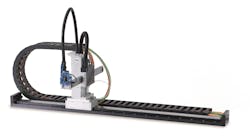Rather than operate along four axes in radial coordinates like traditional Selective Compliance Assembly Robot Arms (SCARA), a new palletizing and tray-packing robot features only three degrees of freedom in Cartesian coordinates. However, that doesn’t mean a downgrade in the robot’s capabilities, according to manufacturer Weiss. In fact, the company claims its simplified axis system saves the customer space and programming effort in a range of industry applications.
The machine costs up to $3000 less than typical SCARA robots, and uses direct linear drives rather than gears. In addition to decreasing maintenance and wear, the drives deliver positioning accuracy up to 0.01 mm. Drives are screwed on directly for effective acceleration and shorter cycle times. More than one robot can be placed on the HN 100 linear motor for assembly and removal.
The main unit uses Weiss HP Pick & Place motors with two degrees of motion, and slides along a four-meter HN 100 linear motor. The robot is programmed in Cartesian coordinates to cover a workspace of 70 by 225 by 200 mm.
The three-axis robot easily reaches standard rectangular DIN pallets of different sizes within the workspace as they move through production on a straight conveyor belt. The four-axis SCARA robots, on the other hand, include an extraneous swivel mechanism about the z-axis, which limits the reach toward rectangular DIN pallets. The 3-axis solution can be customized to include a modular swivel unit, though.
For more information on the three-axis intelligent system, contact Bill Eppich, Vice President of Weiss North America Inc., at [email protected], or call (888) 934-7762.
About the Author
Leah Scully
Associate Content Producer
Leah Scully is a graduate of The College of New Jersey. She has a BS degree in Biomedical Engineering with a mechanical specialization. Leah is responsible for Machine Design’s news items that cover industry trends, research, and applied science and engineering, along with product galleries. Visit her on Facebook, or view her profile on LinkedIn.

